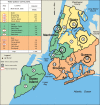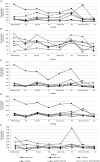Wastewater analysis for nicotine, cocaine, amphetamines, opioids and cannabis in New York City
- PMID: 31304444
- PMCID: PMC6609350
- DOI: 10.1080/20961790.2019.1609388
Wastewater analysis for nicotine, cocaine, amphetamines, opioids and cannabis in New York City
Abstract
According to current surveys and overdoses data, there is a drug crisis in the USA. Wastewater-based epidemiology (WBE) is an evolving discipline that analyses wastewater samples to detect drugs and metabolites to estimate drug consumption in a certain community. This study demonstrates how drug relative presence could be tracked by testing wastewater, providing real-time results, in different boroughs in New York City throughout 1 year. We developed and fully validated two analytical methods, one for 21 drugs and metabolites, including nicotine, cocaine, amphetamines, opioids and cannabis markers; and another for the normalization factor creatinine. Both methods were performed by liquid chromatography tandem mass spectrometry (LC-MS/MS) using positive electrospray ionization, achieving a limit of quantification of 5-10 ng/L for drugs and metabolites, and 0.01 mg/L for creatinine. These methods were applied to 48 one-time grab wastewater samples collected from six wastewater treatment plants in New York City (Manhattan, The Bronx, Queens and Brooklyn), eight different times throughout 2016, before and after major holidays, including Memorial Day, 4th of July, Labour Day and New Year's. In this study, the drug group normalized concentrations present in the wastewater samples, in decreasing order, were cocaine, nicotine, opioids, cannabis and amphetamines. When looking at individual compounds, the one with the highest normalized concentration was benzoylecgonine (BE), followed by cotinine, morphine and 11-nor-9-carboxy-tetrahydrocannabinol (THCCOOH). To estimate community use, these concentrations were multiplied by the corresponding correction factor, and the most present were THCCOOH, followed by BE, cotinine and morphine. When comparing the treatment plants by drug group (nicotine, cocaine, amphetamines, opioids and cannabis), samples collected from The Bronx had the highest normalized concentrations for nicotine, cocaine and opioids; The Bronx and Manhattan for cannabis; and Manhattan and Queens for amphetamines. In most of the cases, no effect due to holiday was observed. This study provides the first snapshot of drug use in New York City and how that changes between key calendar dates employing wastewater analysis.
Keywords: Forensic sciences; LC-MS/MS; amphetamines; cannabis; cocaine; forensic toxicology; nicotine; opioids; wastewater-based epidemiology (WBE).
Figures


Similar articles
-
Quantitative analysis of opioids and cannabinoids in wastewater samples.Forensic Sci Res. 2017 Jan 30;2(1):18-25. doi: 10.1080/20961790.2016.1270812. eCollection 2017. Forensic Sci Res. 2017. PMID: 30483615 Free PMC article.
-
Simultaneous ultra-high-pressure liquid chromatography-tandem mass spectrometry determination of amphetamine and amphetamine-like stimulants, cocaine and its metabolites, and a cannabis metabolite in surface water and urban wastewater.J Chromatogr A. 2009 Apr 10;1216(15):3078-89. doi: 10.1016/j.chroma.2009.01.067. Epub 2009 Jan 29. J Chromatogr A. 2009. PMID: 19201418
-
Analysis of cocaine and nicotine metabolites in wastewater by liquid chromatography-tandem mass spectrometry. Cross abuse index patterns on a major community.Sci Total Environ. 2014 Jul 15;487:673-80. doi: 10.1016/j.scitotenv.2013.10.042. Epub 2013 Nov 5. Sci Total Environ. 2014. PMID: 24200094
-
Liquid Chromatography-Tandem Mass Spectrometry Analysis of Opioids, Benzodiazepines, Cannabinoids, Amphetamines, and Cocaine in Biological and Other Specimens.Forensic Sci Rev. 2008 Jan;20(1):45-73. Forensic Sci Rev. 2008. PMID: 26247342 Review.
-
Addiction and the kynurenine pathway: A new dancing couple?Pharmacol Ther. 2021 Jul;223:107807. doi: 10.1016/j.pharmthera.2021.107807. Epub 2021 Jan 19. Pharmacol Ther. 2021. PMID: 33476641 Review.
Cited by
-
Methamphetamine Disturbs Gut Homeostasis and Reshapes Serum Metabolome, Inducing Neurotoxicity and Abnormal Behaviors in Mice.Front Microbiol. 2022 Apr 18;13:755189. doi: 10.3389/fmicb.2022.755189. eCollection 2022. Front Microbiol. 2022. PMID: 35509309 Free PMC article.
-
Lessons learned from SARS-CoV-2 measurements in wastewater.Sci Total Environ. 2021 Dec 1;798:149177. doi: 10.1016/j.scitotenv.2021.149177. Epub 2021 Jul 21. Sci Total Environ. 2021. PMID: 34375259 Free PMC article.
-
The impact of methamphetamine on liver injury in Iraqi male addicts.Toxicol Rep. 2024 Nov 8;13:101806. doi: 10.1016/j.toxrep.2024.101806. eCollection 2024 Dec. Toxicol Rep. 2024. PMID: 39624223 Free PMC article.
-
Comparative analysis of qPCR and metagenomics for detecting antimicrobial resistance in wastewater: a case study.BMC Res Notes. 2025 Jan 7;18(1):5. doi: 10.1186/s13104-024-07027-9. BMC Res Notes. 2025. PMID: 39773654 Free PMC article.
-
Long-term wastewater-based surveillance and impacts of the COVID-19 pandemic on drug use trends in a U.S. Northeast rural town.Sci Total Environ. 2023 Jun 15;877:162806. doi: 10.1016/j.scitotenv.2023.162806. Epub 2023 Mar 15. Sci Total Environ. 2023. PMID: 36931526 Free PMC article.
References
-
- Ahrnsbrak R, Bose J, Hedden LS, et al Key Substance Use and Mental Health Indicators in the United States: Results from the 2016 National Survey on Drug Use and Health. Rockville (MD): SAMHSA; 2017. (Contract No. HHSS283201300001C). Available from: https://www.samhsa.gov/data/sites/default/files/NSDUH-FFR1-2016/NSDUH-FF....
-
- Rudd RA, Seth P, David F, et al. . Increases in drug and opioid-involved overdose deaths—United States, 2010–2015. MMWR Morb Mortal Wkly Rep. 2016;65:1445–1452. - PubMed
-
- United Nations Office on Drugs and Crime Executive summary. Conclusion and policy implications of the world drug report 2017 [Internet]. World Drug Rep. 2017. Available from: https://www.unodc.org/wdr2017/field/Booklet_1_EXSUM.pdf
LinkOut - more resources
Full Text Sources
Other Literature Sources
Research Materials
Miscellaneous

